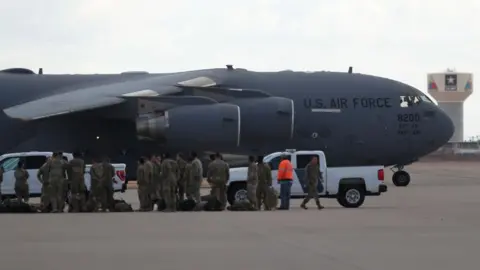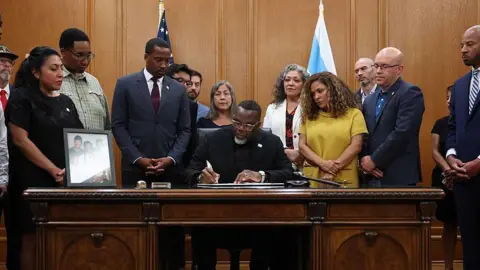In the aftermath of the catastrophic floods that hit Texas, a contentious discussion has emerged regarding whether staffing cuts under the Trump administration adversely affected the National Weather Service's (NWS) capacity to predict and respond to the weather crisis. Prominent Democrats, including Senator Chris Murphy, have voiced concerns that the reduction in federal jobs—including meteorologists—hindered the NWS's ability to deliver timely and accurate weather forecasts. Murphy stated, “Accurate weather forecasting helps avoid fatal disasters,” implying that the cuts could have had dire consequences.
Conversely, White House Press Secretary Karoline Leavitt refuted these claims, asserting on Monday that "these offices [of the NWS] were well staffed," and labeled the accusations as "completely false." Investigations by BBC Verify have highlighted that while the NWS workforce has indeed decreased—resulting in the loss of around 600 positions from a total of 4,200—experts maintain that adequate staff was present during the floods.
Under President Trump, a proposed budget cut of 25% to the National Oceanic and Atmospheric Administration (NOAA), which supervises the NWS, could begin in the 2026 financial year. However, concurrent efficiency measures have already led to a workforce decline within the agency, with voluntary redundancies and early retirements among employees. A report from April noted a concerning vacancy rate of 20% across half of the NWS offices, a rate double that of a decade ago.
Despite staffing reductions, Texas weather experts assert that the NWS's forecasts and warnings issued during the floods were appropriate given the extreme nature of the localized rain events. "The forecasts and warnings all played out in a normal manner," remarked Avantika Gori, a civil and environmental engineering professor at Rice University. Andy Hazelton, a former NOAA climate scientist, echoed this sentiment, insisting that staff reductions did not directly cause the issues faced during this particular event.
However, some scientists have pointed out potential communication challenges between local NWS offices and emergency responders. Daniel Swain from UCLA suggested that the cuts may have limited the ability of local offices to coordinate effectively with emergency services. Reports indicated that vacancies existed in critical positions, such as a senior hydrologist in the San Angelo office and a warning coordinating meteorologist in the San Antonio office. Nonetheless, Erica Grow Cei, a spokesperson for the NWS, emphasized that the necessary personnel were temporarily augmented prior to the flooding, which is a standard operational practice.
Adding to the debate, meteorologist John Morales raised concerns about a 20% reduction in weather balloon launches, a critical method for gathering atmospheric data. Shared widely on social media, Morales asserted that these reductions could degrade the quality of forecasts. While the NWS has indeed suspended or reduced weather balloon launches in multiple locations due to staffing issues, it remains uncertain if these changes measurably impacted the areas affected by Texas's floods. According to available data, weather balloons were launched regularly from Del Rio—the closest station to the flood-impacted regions—thereby enabling accurate weather forecasting.
As investigations continue, the intersections of policy, weather forecasting, and emergency response remain in the spotlight, raising crucial questions about preparedness in the face of increasingly severe weather events.




















